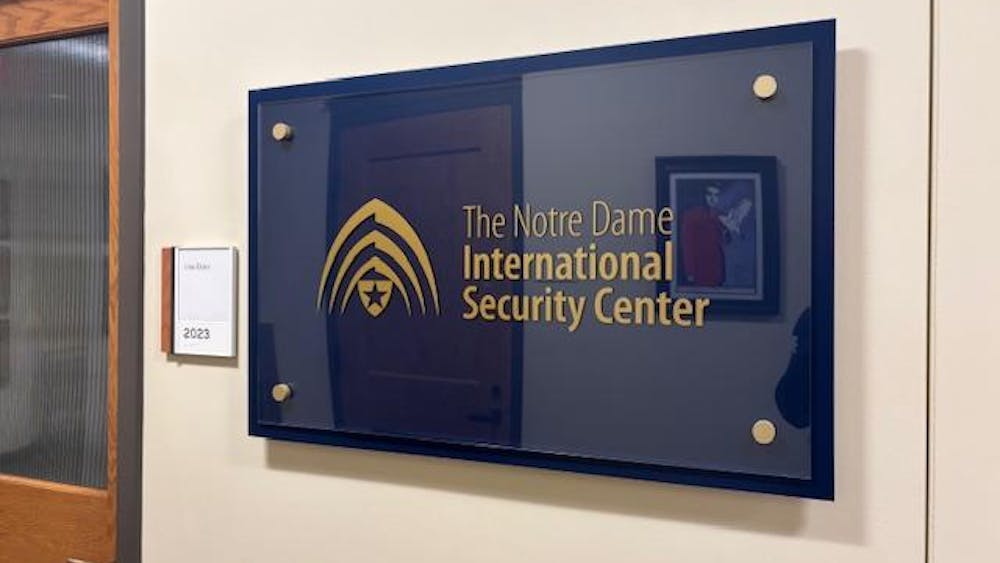On Thursday evening, the Cushwa-Leighton Library was full of people eager to hear about the history of LGBTQ+ people at Saint Mary’s College, titled “‘We Have Been Here Since 1844’: Queer History at SMC”.

Dr. Jamie Wagman gives the audience an overview of the project and introduces the students involved.
Dr. Jamie Wagman gives the audience an overview of the We Have Been Here Since 1844’: Queer History at SMC project and introduces the students involved.
Professor Jamie Wagman’s class “Doing History” is dedicated to history research methods. This event, “We’ve Been Here Since 1844”, is one of the students’ major assignments.
“The class really gives students an opportunity to get into archives to do oral histories with people,” Wagman said. “So this was a project I’d had on the backburner for a little while and I thought that I knew enough about queer history at Saint Mary’s that I felt like there was enough resources now to create an exhibit. I pointed students in a bunch of directions and let them loose.”
Wagman presented her own research on queer histories at Saint Mary’s over a year ago to the Board of Trustees.
“That allowed me to do a deep dive into what sources exist in our college archive,” she said. “Because of the history of discrimination both nationally and also on our campus, these stories are really buried.”
It was at this Board of Trustees meeting that Wagman first met Jacqueline Leskovec, a member of the Board of Trustees and SMC graduate from the class of 1974. Leskovec is also one of the founding members of Pride SMC, an affinity group of Saint Mary’s College.
Leskovec was not only in attendance at the event, but had a whole case of artifacts from her time as a LGBTQ+ student at SMC in the early 70's.
“Back when I was a junior, Professor Penny Jameson had created a class called Psychology of Women,” Leskovec said, pointing to the textbook in the case, which come with a placard describing how this class allowed Leskovec to further understand her sexuality. “I held on to those two textbooks from that class because they were one of the first texts that came out that talked about the psychology of women.”
“I think its really important to make this known,” Leskovec said about the exhibit as a whole. “There is my story, other stories, they could all be hidden unless someone steps forward and makes them known.”
“Hopefully, it will bring some awareness to people to know now this is not a passing thing. This is something that is our history, its entire history of the college.”
Other displays of the exhibit ranged from timelines of events, photographs, artifacts and old newspaper articles, including those from The Observer.
Emma Feller, a senior involved with the project, had a hand in creating a timeline for the exhibit.
“I started with a timeline and then I found a lot of cartoons, photos, quotes from The Observer, from the archives from like 1973 until now,” she said.
Feller talked about the range of opinions her research dug up.
“Generally, it was more on the positive side but I did include some of the negatives because I wanted to show that it’s not all rainbows and sunshine when talking about such a silenced group of people.”
Feller also talked about the obstacles she ran into while researching and creating her part of the presentation.
“It was very hard to find Saint Mary’s specific research because a lot of times, Notre Dame would silence the community and in the background, Saint Mary’s would be there trying to uplift.”
“I think the timing of it is very prevalent,” Feller added. “I’m very proud that we were able to put all this together considering the current climate and that everyone felt empowered to actually talk about this even more so.”

Attendees gather around cases that display artifacts of the LGBTQ+ history of Saint Mary's.
Sophomore Mac Weber-Hess also is a student in Wagman’s class who helped with the presentation.
“I was looking specifically at the trans experience at Saint Mary’s and what that has looked like over pretty close to two decades,” Weber-Hess said. “Mostly because there is not a lot of information prior to the 2000’s.”
“There is a lot to sift through,” Weber-Hess said about the biggest struggles of their research. “Not a lot actually pertains specifically to Saint Mary’s, there is a lot more that pertains heavily to Notre Dame, which is influential of how we conduct ourselves here.”
Weber-Hess talked a lot about transgender pride events. “There was a Trans-pride protest in 2016. That was meant to show a lot of support for queer and trans students here in light of the election.”
They also talked about how it was learning about events like these that made them most excited about the queer history of Saint Mary’s. “I do like the picture that comes from that protest in 2016 and I think it’s because you can tell it is Saint Mary’s, you can tell that it the green outside of McCandless [Hall].”
However, according to Weber-Hess, with the positive again comes the negative.
“Every other article, it felt like something was negative. I can’t pick out any single thing because its just insidious,” Weber-Hess said. “It’s not always just in your face ‘I’m going to be homophobic’ or ‘I’m going to be transphobic’. Or just like, ‘I don’t care to be positive to other peoples' existence’ and the casual way of bigotry.”
Weber-Hess also found in their research that “There’s a lot out there that pertains more to Notre Dame than Saint Mary’s. So like a lot of negative things were coming out of Notre Dame.”
Wagman discussed how the class will be donating the project to the College’s archives.
“In 10 years when the next person says ‘Hey, what is the queer history of Saint Mary’s?’, there will actually be a collection.”









